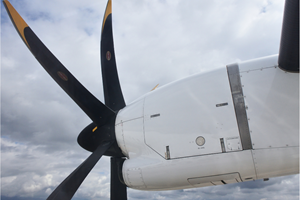Lilium expands on latest sourcing decision, go-to-market strategy
Lilium COO Yves Yemsi discusses the decision to source composite structures from Aeronnova and Aciturri, and how the company’s M&P choices might evolve.
Advanced air mobility (AAM) specialist Lilium (Munich, Germany) announced recently that it has chosen aerospace manufacturer Aeronnova Aerospace S.A. (Miñano Mayer, Spain) to design and manufacture the propulsion mounting system for the Lilium Jet eVTOL aircraft. This follows Lilium’s early 2021 announcement that Aciturri (Miranda de Ebro, Spain) had been chosen to fabricate primary composite and metallic structures for the Lilium Jet.
The Lilium Jet is being developed as a piloted, fixed-wing eVTOL air taxi with seating for up to four passengers. It is powered by 30 tilting ducted fans mounted on the leading edge of each wing and the horizontal tail fin. It’s designed for intercity service and has a physical range of 250 kilometers and a maximum cruising speed of up to 280 kilometers per hour. Lilium COO Yves Yemsi talked to CW about the choice of Aeronnova and how it fits with Lilium’s overall go-to-market strategy.
Yemsi says that, because Lilium is developing an aircraft for a new mobility marketplace, the company is keen to de-risk its structures fabrication by leveraging established aerospace supply chains. This means Lilium will, for its first-generation aircraft, depend on already-qualified materials (prepreg) and processes (hand layup, autoclave cure) deployed by vendors like Aeronnova and Aciturri, which have a long history serving the EU market. “We were looking for know-how and safety,” says Yemsi. “Our low-risk approach means we depend, initially, on the existing supply chain.”
The Lilium Jet propulsion mounting system, for example, says Yemsi, serves many functions, including blade containment, noise attenuation and support of the entire aircraft load during horizontal travel. In addition, each rotor is mounted within an aperture that must be fabricated to exact dimensions. Aeronnova’s strong engineering capabilities, says Yemsi, make the company well suited for the application.
Lilium, he adds, is close to completing primary design review on its first aircraft and will soon deliver the design to the company’s suppliers. Assembly of the first aircraft will follow, leading up to first flight. According to the AAM Reality Index, the Lilium Jet’s entry into service (EIS) is 2025.
Looking to the future, Lilium and Yemsi face many questions about structures fabrication. Assuming the Lilium Jet enters service and sees demand for the aircraft grow, the company conceivably will come up against the challenge of producing structures at a rate that cannot be met cost effectively using hand layup. At that point, the company may have to make some hard materials and process (M&P) choices. These choices may necessitate, Yemsi admits, development of a second-generation aircraft that will have to be separately certified. (Lilium is pursuing concurrent certification with the European Union Aviation Safety Agency (EASA) and the U.S. Federal Aviation Administration (FAA).)
Yemsi says he envisions moving toward automation and “getting away from hand layup” eventually, but he cannot commit completely to such a strategy. “Our shift to automation will be driven by the business case and cost effectiveness,” he says. “Each part will have its own shape, and that will dictate M&P. And in all cases, I think we will favor materials already qualified on other programs.”
What about thermoplastic composites and processes like resin transfer molding (RTM)? Yemsi’s view is that thermoplastics, at present, are not on Lilium’s radar. RTM, he says, is a feasible manufacturing process. He says he would not be surprised if Lilium’s second-generation aircraft was fabricated with some combination of hand layup, automation (ATL/AFP) and RTM. “A combination of technologies seems very possible to me,” he says.
The bottom line for Lilium and Yemsi is to follow a careful, deliberate path to aircraft development. This includes aerostructures. “I am now risk-averse,” Yemsi reiterates. “I don’t want to do R&D in the middle of the program. I want to go step by step and I want margins. When the Lilium Jet enters service, I want to feel confident that we did it the right way.”
Related Content
Carbon fiber in pressure vessels for hydrogen
The emerging H2 economy drives tank development for aircraft, ships and gas transport.
Read MoreComposites end markets: Aerospace (2023)
With COVID in the past and passengers flying again, commercial aircraft production is ramping up. The aerocomposites supply chain is busy developing new M&P for an approaching next-generation aircraft program.
Read MoreWe're going to need a lot of propeller blades
As advanced air mobility expands and annual shipsets get into the thousands, the demand for composite propeller blades is expected to skyrocket. What are the implications for the composites supply chain?
Read MoreMaterials & Processes: Fibers for composites
The structural properties of composite materials are derived primarily from the fiber reinforcement. Fiber types, their manufacture, their uses and the end-market applications in which they find most use are described.
Read MoreRead Next
From the CW Archives: The tale of the thermoplastic cryotank
In 2006, guest columnist Bob Hartunian related the story of his efforts two decades prior, while at McDonnell Douglas, to develop a thermoplastic composite crytank for hydrogen storage. He learned a lot of lessons.
Read MoreComposites end markets: Energy (2024)
Composites are used widely in oil/gas, wind and other renewable energy applications. Despite market challenges, growth potential and innovation for composites continue.
Read MoreCW’s 2024 Top Shops survey offers new approach to benchmarking
Respondents that complete the survey by April 30, 2024, have the chance to be recognized as an honoree.
Read More












.jpg;maxWidth=300;quality=90)













